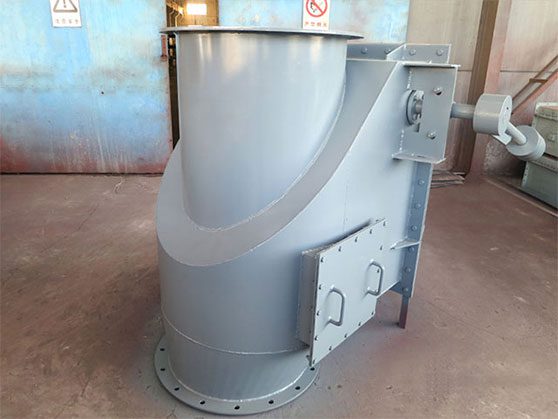How does a preheater flap valve work?
The preheater flap valve operates by opening and closing the valve plate. This is done through the transmission and control of the valve rod. During the flue gas preheating process, the flap valve regulates the flow, temperature, and direction of the flue gas. It serves both guiding and blocking functions. When the valve is closed, the flue gas is directed to the next heat exchanger, thereby preheating it. When the valve is open, the flue gas can be directed to other equipment or discharged directly into the atmosphere.
The preheater flap valve is mainly used in the flue gas preheating process of heat exchangers, and its functions include the following aspects:
Guiding and Blocking: By opening and closing the valve plate, it controls the flow of flue gas. This also manages the blockage of flue gas, thus influencing the direction and quantity of heat transfer.
Regulating Flue Gas Flow and Temperature: By controlling the degree of valve opening, it can adjust the flow of flue gas. It also adjusts the temperature of the flue gas, allowing for more precise thermal control.
Protecting Equipment: With the preheater flap valve in operation, heat exchangers experience less wear. This reduces corrosion and extends the equipment's lifespan.
Technical data and Characteristic
Specification
| Type | OD/mm | ID/mm | Height /mm | Weight/kg | Operating range |
| D-FBF-600 | 612 | 440 | 1200 | 600 | Vertical inclined blanking pipe for general use |
| D-FBF-700 | 712 | 500 | 1380 | 740 | Vertical inclined blanking pipe for general use |
| D-FBF-800 | 812 | 600 | 1550 | 870 | Vertical inclined blanking pipe for general use |
| D-FBF-900 | 912 | 700 | 1680 | 980 | Vertical inclined blanking pipe for general use |
| D-FBF-1000 | 1012 | 800 | 1750 | 1120 | Vertical inclined blanking pipe for general use |
| D-FBF-1100 | 1112 | 900 | 1820 | 1250 | Vertical inclined blanking pipe for general use |
| D-FBF-1200 | 1212 | 1000 | 1980 | 1400 | Vertical inclined blanking pipe for general use |
| D-SFBF-600 | 612 | 440 | 900 | 800 | Vertical or Angle less than 10° feeding pipe |
| D-SFBF-700 | 712 | 500 | 1000 | 900 | Vertical or Angle less than 10° feeding pipe |
| D-SFBF-800 | 812 | 600 | 1100 | 1050 | Vertical or Angle less than 10° feeding pipe |
| D-SFBF-900 | 912 | 700 | 1200 | 1120 | Vertical or Angle less than 10° feeding pipe |
| D-SFBF-1000 | 1012 | 800 | 1300 | 1240 | Vertical or Angle less than 10° feeding pipe |
| D-SFBF-1100 | 1112 | 900 | 1400 | 1380 | Vertical or Angle less than 10° feeding pipe |
| D-SFBF-1200 | 1212 | 1000 | 1500 | 1550 | Vertical or Angle less than 10° feeding pipe |
| D-XSFBF-600 | 612 | 440 | 1380 | 1000 | Vertical or Angle less than 45° feeding pipe |
| D-XSFBF-700 | 712 | 500 | 1480 | 1050 | Vertical or Angle less than 45° feeding pipe |
| D-XSFBF-800 | 812 | 600 | 1580 | 1120 | Vertical or Angle less than 45° feeding pipe |
| D-XSFBF-900 | 912 | 700 | 1680 | 1240 | Vertical or Angle less than 45° feeding pipe |
| D-XSFBF-1000 | 1012 | 800 | 1780 | 1380 | Vertical or Angle less than 45° feeding pipe |
| D-XSFBF-1100 | 1112 | 900 | 1880 | 1500 | Vertical or Angle less than 45° feeding pipe |
| D-XSFBF-1200 | 1212 | 1000 | 1980 | 1620 | Vertical or Angle less than 45° feeding pipe |
Popular highlight
During use, the flap valve opens when a certain weight of material is pressed on the valve plate. Under the force of gravity from the material, the valve plate rotates around its axis, allowing the material to be fed into the airflow while also providing a sealing function. The flap valve permits the material to pass through, closing off idle areas and preventing backflow. The flap valve can be adjusted based on the amount of material being discharged, using a counterweight for regulation.
The preheater flap valve features :
- The sealing effect is good.
It ensures that the system operates efficiently without any unintended loss of materials or energy. This high-quality sealing mechanism plays a crucial role in maintaining optimal performance levels.
- Preventing internal leakage of air.
By minimizing air leaks, we can maintain consistent pressure and temperature conditions, which are vital for various industrial processes.
- Prevent airflow from entering the discharge pipe.
Prevent airflow from entering the discharge pipe helps to ensure that only intended materials are expelled from the system.
This control over airflow not only enhances operational efficiency but also reduces contamination risks associated with unwanted external elements.
- Prevent air leakage.
Prevent air leakage is critical in applications where precision and accuracy are paramount. Effective measures against air leakage contribute to improved overall functionality and reliability of equipment, thereby extending its lifespan and reducing maintenance costs.
- Improve the heat exchange efficiency between the material and the air flow.
Enhanced heat exchange allows for more effective utilization of energy resources, resulting in lower operational costs while achieving desired temperature outcomes more rapidly.
- Reduce heat consumption.
By optimizing heating processes through efficient design features, organizations can significantly decrease their carbon footprint while simultaneously lowering utility expenses associated with excessive energy use.
For more information or technical inquiries, please feel free to contact us. We are happy to assist you.




